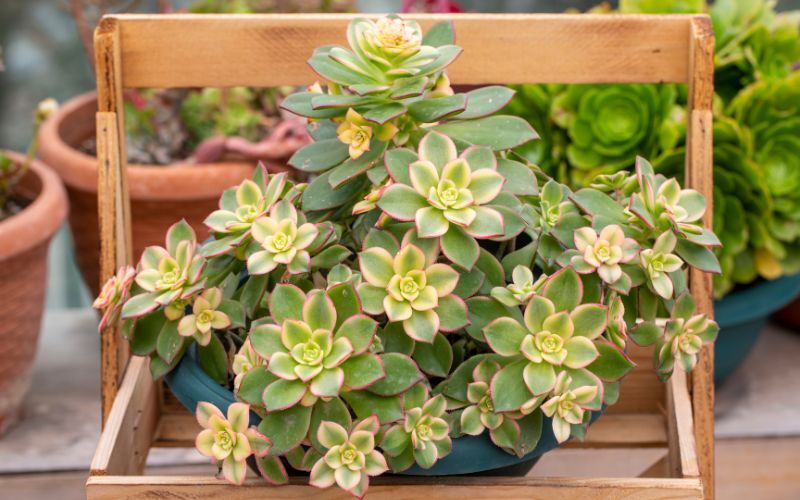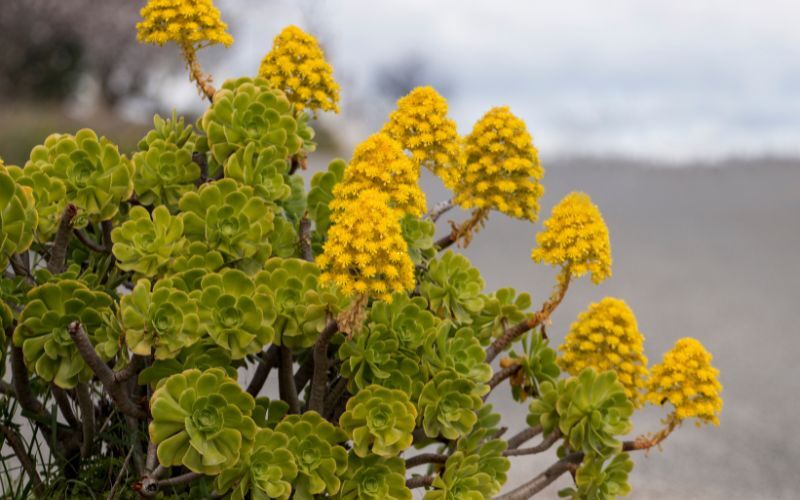Even though succulents tend to thrive in soils with low levels of nutrients if they were growing in a garden bed or their native growing range the nutrition that they require would be plentiful and easily accessed by a spreading root system. Pot-grown plants require supplemental fertilizing on a regular schedule because they are restricted to where their roots can seek out moisture and nutrition. Fertilizing during the active growing periods of spring and fall supports healthy and strong growth for Aeoniums.

Why Fertilize Fertilizing Aeonium
Fertilizing Aeoniums is intended only to support regular and healthy growth of the stems and foliage and does not fix most of the common growing issues. Aeoniums are monocarpic plants that die after they have bloomed and set seed. Extra doses of fertilizer do not encourage more blooms and will most likely only result in a plant that has spindly growth that is weak and susceptible to an invasion of pests or disease.
Only feed Aeoniums during periods of active growth. Extra watering and fertilizing of any plant when it is in a dormant state at the very least washes out of the pot and at the most will encourage root rot issues.

How Often To Fertilize Aeonium
During the spring and again in the fall are the main growing periods for Aeonium. A once-a-month feeding in place of watering is ideal. Allow the soil to soak up as much of the diluted fertilizer as possible by watering from the bottom or allowing the pot to sit in a drainage saucer for up to 30 minutes after watering.
Drain the pot well before placing it back in its regular growing position. Stop fertilizing for three months in the winter and again during the summer.
How To Tell If Aeonium Needs Fertilizer
Because Aeonium requires very little fertilization, most often gardeners will notice signs of overfeeding first. This can be yellowing of the leaves, burning of the leaf tips and edges, and stunted or spindly growth of both the leaves and stems.
Over-fertilizing is easily corrected when caught early with a good flushing out of excess salts and nutrients from the potting mix or a repotting of the plant. Underfeeding results in leaves that are pale or off-color and very slowed growth during the normal active period.
Best Fertilizer For Aeonium
A water-soluble fertilizer that has a balanced NPK ratio is easy to use instead of a watering session and is quick-acting for your Aeonium. Look for formulations specifically for succulents and/or cacti to provide the right micronutrients, such as calcium, which supports strong cell growth.
Organically certified fertilizers will have the OMRI (Organic Materials Review Institute) somewhere on the label. Brands such as Dr. Earth and Neptune’s Harvest are easily found at most garden centers or online specialty shops. Use half the amount of recommended fertilizer to keep excess salts from building up in the potting mix.
Aeonium Fertilizing Tips
Fertilize Aeonium only during the period of rapid growth in spring and again in the fall. Slowed growth or pale color are two common signs that fertilization is necessary.
- Over-fertilizing will not encourage flowering, only poor growth
- Under fertilizing results in slowed growth and possibly pale foliage color
- Use a water-soluble formulation diluted to half the recommended dosage
- Fertilizers marketed specifically for succulents will have the right amounts of micronutrients
Warnings
-Always wear protective gloves and a face mask when handling chemical fertilizers.
-Closely follow all directions and storage guidelines that are on the fertilizer label.
Sources: “Aeonium”. University of Wisconsin Extension division. www.hort.extension.wisc.edu

Author Robbin Small - Published 27-12-2024 |
